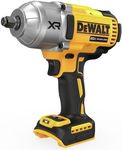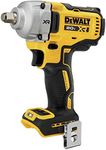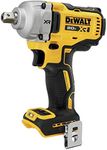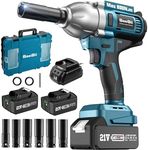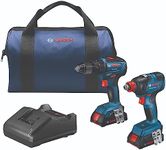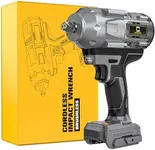Buying Guide for the Best Cordless Impact Wrenches
Choosing a cordless impact wrench can make your work much easier, whether you're a DIY enthusiast, a car owner, or a professional. The right tool will help you loosen or tighten bolts quickly and efficiently, without the hassle of cords or air compressors. To find the best fit, it's important to understand the main features and how they relate to your needs. Think about the types of tasks you'll be doing most often, the size of fasteners you'll work with, and how much portability and convenience matter to you.VoltageVoltage refers to the power output of the cordless impact wrench's battery. Higher voltage usually means more power, which is useful for tougher jobs like loosening stubborn bolts or working on larger vehicles. Most cordless impact wrenches come in ranges like 12V, 18V, or 20V. Lower voltage models are lighter and easier to handle, making them suitable for lighter tasks or prolonged use, while higher voltage models are heavier but can handle more demanding jobs. Choose a voltage that matches the intensity of your typical tasks—go higher for heavy-duty work, and lower for lighter, more frequent use.
TorqueTorque is the force the wrench can apply to a bolt or nut, usually measured in Newton-meters (Nm) or foot-pounds (ft-lbs). Higher torque means the tool can handle tougher, more stubborn fasteners. Light-duty wrenches may offer around 100-200 Nm, which is enough for small household tasks or light automotive work. Medium-duty models range from 200-400 Nm, suitable for most car maintenance. Heavy-duty wrenches can exceed 400 Nm, ideal for trucks, construction, or industrial use. Consider the toughest job you expect to do and pick a torque rating that covers it, but avoid going much higher than you need, as higher torque tools are often heavier and harder to control.
Battery CapacityBattery capacity, measured in ampere-hours (Ah), tells you how long the tool can run before needing a recharge. Higher capacity batteries last longer but are heavier and more expensive. For occasional or short tasks, a 2.0Ah battery may be enough, while frequent or prolonged use might require 4.0Ah or more. Think about how long your typical job takes and whether you want to avoid frequent recharging—if so, opt for a higher capacity battery.
Drive SizeDrive size refers to the size of the square fitting where you attach sockets, commonly 1/4-inch, 3/8-inch, or 1/2-inch. Smaller drive sizes are lighter and better for tight spaces or smaller fasteners, while larger drive sizes can handle bigger sockets and more torque. For general automotive work, 1/2-inch is most common, while 3/8-inch is good for lighter tasks. Match the drive size to the sockets you already own or the size of bolts you expect to work with most often.
Weight and ErgonomicsThe weight and design of the impact wrench affect how comfortable it is to use, especially for long periods. Lighter models are easier to handle and reduce fatigue, but may offer less power. Ergonomic handles and balanced designs make the tool more comfortable and safer to use. If you expect to use the wrench for extended periods or in awkward positions, prioritize a lighter, well-designed model.
Speed SettingsSpeed settings, often measured in revolutions per minute (RPM), let you control how fast the wrench turns. Some models offer variable speed triggers or multiple preset speeds. Lower speeds are useful for starting bolts or working with delicate materials, while higher speeds help remove fasteners quickly. If you need versatility for different tasks, look for a model with adjustable speed settings.
